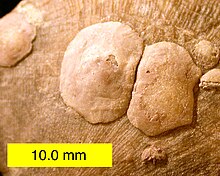Craniidae
| Craniidae Temporal range:
| |
|---|---|

| |
| Petrocrania brachiopods attached to a strophomenid brachiopod; Upper Ordovician of southeastern Indiana. | |
| Scientific classification | |
| Domain: | Eukaryota |
| Kingdom: | Animalia |
| Phylum: | Brachiopoda |
| Class: | Craniata |
| Order: | Craniida Waagen, 1885 |
| Suborder: | Craniidina Waagen, 1885 |
| Superfamily: | Cranioidea Menke, 1828 |
| Family: | Craniidae Menke, 1828 |
| Genera | |
| |
| Synonyms | |
|
Valdiviathyrididae | |
The Craniidae are a family of brachiopods (lamp shells). Although it belongs to a subdivision called the inarticulata which have shells where the mineral content consist of calcium phosphate, the Craniidae have shells that consist of calcium carbonate. Other special characteristics of this family are that no outgrowths are developed to form a hinge between both valves, nor is there any support for the lophophore. As adults, craniids, either lived free on the ocean floor or, more commonly, were attached to a hard object with all or part of the ventral valve. All other brachiopods are supposed to have a stalk or pedicle, at least as an adolescent, but in craniids a pedicle is not known from any development stage.[2]
They are the only members of the order Craniida and the monotypic suborder Craniidina and superfamily Cranioidea; consequently, the latter two taxa are presently redundant and not used very often. Valdiviathyris and Neoancistrocrania were sometimes separated in a family Valdiviathyrididae but this has turned out to be unjustified.[3]
Most Craniidae are long extinct forms known only from fossils like all other Craniforma. However, some 20 species of this 470-million-year-old lineage are extant today. They include Valdiviathyris quenstedti which has remained essentially unchanged for the last 35 million years or so. Although some minimal evolution would obviously have taken place in the meantime, this was essentially silent mutations and marginal adaptations to cooler habitat. Present-day Valdiviathyris are all but inseparable from those of the Late Eocene and the genus cannot even be divided into chronospecies. Thus, V. quenstedti is a true living fossil and one of the oldest and most long-lived species known to science.[3]
References
- ^ Emig, Christian C. (2009). "Nummulus brattenburgensis and Crania craniolaris (Brachiopoda, Craniidae)" (PDF). Carnets de Géologie/Notebooks on Geology (08).
{{cite journal}}: line feed character in|title=at position 49 (help) - ^ Moore, R.C. (1965). Brachiopoda. Treatise on Invertebrate Paleontology. Vol. Part H., Volume 1. Boulder, Colorado/Lawrence, Kansas: Geological Society of America/University of Kansas Press. pp. H6, H93. ISBN 0-8137-3015-5.
- ^ a b Robinson & Lee (2007)
- Robinson, Jeffrey H. & Lee, Daphne E. (2007): The Recent and Paleogene craniid brachiopod, Valdiviathyris quenstedti Helmcke, 1940. Systematics and Biodiversity 5(1): 123–131. doi:10.1017/S1477200006002179 (HTML abstract)
